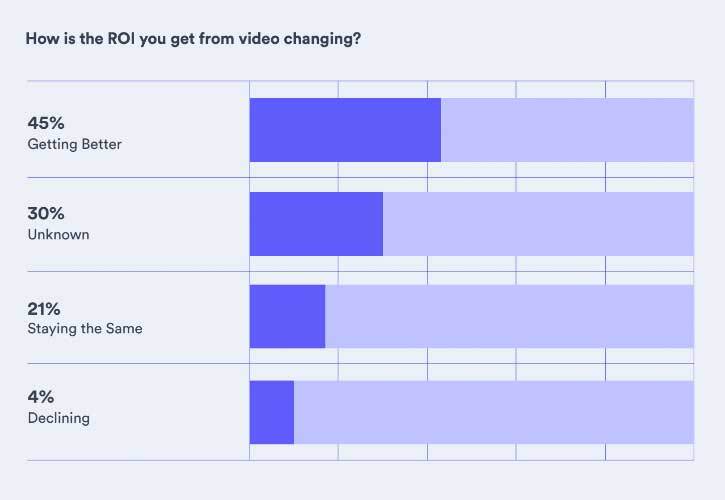The Video Analytics Metrics You Need to Track
Views aren't the only way to measure the performance of your videos. From CTR to pipeline, there are plenty of metrics you track to prove the ROI of your video program.
So you’ve created some videos. You’re peppering them into your marketing, sales, support, and elsewhere throughout your business. You’ve even integrated your video platform with your customer relationship management (CRM) and marketing automation platforms to track views on the lead and account level. That’s all terrific. But how do you know whether it’s, you know, working without the video analytics to back it up?
If your CEO was to suddenly ask which videos have been the most effective—which ones you should continue making—how would you answer?
Analytics is a key component in any successful video marketing strategy.
Learn more about the importance of measuring your videos’ performance against preset goals and how to use your audience’s video metrics to determine if your videos are earning a return on investment (ROI).

 Know where you stand, so you can stand out. Get the insights you need to craft a video strategy that works. Get the Report
Know where you stand, so you can stand out. Get the insights you need to craft a video strategy that works. Get the Report - Contents
- Why Do Video Marketing Metrics Matter?
- What Video Metrics Matter Most for Your Program?
- How to Measure Your Video Marketing ROI
- Where Do Video Marketing Metrics Come From?
- Setting Goals to Help Determine the ROI of Video Marketing
Why Do Video Marketing Metrics Matter?
Video metrics give marketers the power to improve and are critical to your video marketing strategy. Only through tracking views, attention spans, click-through rates (CTR), and more can we identify which videos work and whether they help generate leads, crack key accounts, add pipeline, retain customers, or realize revenue. To this end, video analytics is essential.
According to findings from Demand Metric, 83% of businesses now use some form of video analytics to track content effectiveness. This is because—no surprise—measuring your videos tends to help you track whether your ROI on video is improving.

Two-thirds of all study participants report that ROI on video is getting better or staying the same. Source: Demand Metric State of Video Report.
Video data is also uniquely useful to data-driven teams. Unlike traditional assets like blog posts, eBooks, and emails—which only tell you whether someone visited or opened something—videos produce intent data. Teams can measure how much of a video individual prospects watched, what parts they rewatched, and who they shared it with.

 Know where you stand, so you can stand out. Get the insights you need to craft a video strategy that works. Get the Report
Know where you stand, so you can stand out. Get the insights you need to craft a video strategy that works. Get the Report What Video Metrics Matter Most for Your Program?
Metrics for individual videos tell you whether particular topics or stories, such as a holiday video, resonated with your audience (ours did!).
Overall video program metrics, on the other hand, tell you whether your video program has been a profitable investment and suggest ways to increase those returns. Let’s explore both.
Metrics for Individual Videos
Overall View Count
The first question video marketing practitioners get after a new video goes live is often, “How many views did we get?” It’s a fair question, and while interesting, it’s also misleading—views are just a vanity metric unless paired with more meaningful measurements like video engagement stats.
For example, if an HR software company released a heart-tugging holiday video that went viral to the tune of millions of views, it could be a whopping failure if none of the viewers were in the target audience of people who’d actually need their solution. If, on the other hand, the video earned just 200 views, but they were all decision makers at Fortune 500 companies, it could be a huge win.
If you find that your view counts are low, or begin to drop, revisit your video distribution strategy. Are you publishing on channels where prospects are and are likely to watch? Are you using interesting titles and video thumbnails?
Attention Span Data
Video length is important in retaining viewers, but it’s not everything. Despite the pervasive myth about goldfish-sized attention spans, modern viewers will sit through anything that’s genuinely entertaining or useful.
In fact, 53% of viewers will watch a video all the way to the end—regardless of how long the video is.
60% of videos are under two minutes long. As videos have grown substantially more popular for sales and customer conversations, the prevalence of shorter videos isn’t surprising.
Lots of companies have success with in-depth educational videos that exceed 30 minutes. The length depends on the video type, funnel stage, and audience, which you must test for yourself.
What is the Average Length of B2B Videos?

60% of videos are reported at under two minutes long. Source: Video in Business Benchmark Report.
In this quick-cut version of a Fast Forward Session, Vidyard’s Christina Garland discusses using Vidyard Analytics to understand video ROI better.

Broadly, you can consider a video successful if at least 60% of viewers watch the whole thing, also known as the video completion rate.
If your finish rate is significantly lower, you could have the wrong format or length. Shorter videos are more effective higher up in the funnel when prospects aren’t yet invested, and longer ones work better at later stages.
It could also be that your videos contain the wrong subject matter. Early-stage prospects are often interested in hearing about benefits, whereas later-stage prospects want to know about cost and implementation.
The optimal length for videos varies based on type, channel, and topic. Here are a few rules of thumb:
- Explainer videos: > 60 seconds
- Product videos: 1-3 minutes
- Sales videos: 15-60 seconds
- Webinars: 15-60 minutes
- Social videos:
- Instagram: 15-30 seconds
- Twitter: 15-30 seconds
- LinkedIn: 15 seconds to 2 minutes
- Facebook 15 seconds to 2 minutes
Total Video Click-Through Rate (CTR)
When prospects see your video, do they click? The total video click-through rate (CTR), also known as the play rate or view rate, is the total views divided by the number of people who clicked.
Video click-through rate = # of views / # of people who clicked
CTR has nothing to do with the quality of your video content and everything to do with how interesting your title, call to action (CTA), and thumbnail are. Make your titles as intriguing as possible while accurately explaining what the video is about without giving away too much. Use a verb in your CTA and customize your thumbnail image to invite viewers to click.
The best thing you can do to increase a video’s CTR is to make it the main focal point of your landing page or video email. If you take a look at Vidyard’s campaigns, you’ll notice our video player occupies most of the space above the fold, and the pages themselves don’t distract viewers with excessive text, buttons, or graphics.
Another great way to drive up CTRs is to test your video’s thumbnail image to figure out which one your audience prefers. Using a tool like Vidyard, you even have the option to select or upload a custom thumbnail.
Link Click-Through Rate (Link CTR)
Similar to the total CTR, link CTR measures which links or interactive elements within the video viewers clicked, such as a popup to download an eBook.
If your link CTR is low, try testing different CTAs, or move them to earlier in the video so they appear right when viewers are most engaged.
What Is the Benchmark for a Video CTA?
If your link CTR is low, test different CTAs, or move them to earlier in the video to appear right when viewers are most engaged. The CTR benchmark for video CTAs is 3.21%, which should increase the more relevant your CTA is to your video content.
Metrics for Overall Video Performance
In the second phase of video analysis, you’ll want to measure the performance of your video marketing analytics efforts as a whole to determine whether they’re:
- Driving leads or meetings
- Driving sales pipeline
- Influencing deals
To determine this, you’ll need to integrate your video platform with your marketing automation platform and CRM. Inside one of those two, you can view reports and find answers.

 Know where you stand, so you can stand out. Get the insights you need to craft a video strategy that works. Get the Report
Know where you stand, so you can stand out. Get the insights you need to craft a video strategy that works. Get the Report Lead Generation and Qualification
Are your videos generating net-new leads that can be passed along to sales? If your team practices account-based marketing (ABM), are videos influencing deals and helping engage the whole buying committee?
Examine first-touch, last-touch, and, if it’s set up, multi-touch attribution for your video program as a whole to get a sense of where it plays a part in deals.
If you use a lead or account scoring system, use your lead data to push prospects forward in their journey. Teams can set scoring rules so that different video formats count differently. For example, a long testimonial should be worth more points than a quick sales video, and the same goes for when a prospect views an entire video versus only watching the first minute.
Teams can also create automatic alerts so the sales rep tied to an account gets notified if a prospect begins binge-watching demos like they’ve discovered a Game of Thrones bonus season.
As prospects’ scores grow, you can tailor the types of video content they receive. Any prospect that’s enjoying demo videos is probably past the point of needing an animated explainer and should be receiving late-stage content from that point on.
How to Measure Your Video Marketing ROI
Teams can cross-reference their revenue data from their CRM with video viewing data to determine:
- How video views have influenced deals
- Which individual contacts, leads, and accounts viewed which videos
- Video views by month, quarter, or year
- Video views by volume of content watched
Within these CRM reports, you can see a visual breakdown of videos watched by contacts associated with closed-won opportunities. You can determine which videos are often watched by contacts that convert. That is, you’ll know exactly which content makes a difference in revenue.
Do more of it whenever you find videos with an outsized impact—say, a particular webinar that shows up in nearly every deal.
Construction tech company Gordian knows the power of video measurement. They use Vidyard to host and manage their video content and leverage analytics alongside Marketo and Salesforce integrations to get critical insights about their video campaigns.
This was especially important when they launched a massive five-video campaign designed to guide prospects along the buyer’s journey. They used Marketo forms to gate the videos and lead score in Marketo based on the percentage viewed.
Then, the converted leads who watched a certain percentage of the videos into a Salesforce campaign. The data told them who was watching which parts of the series so that they could identify their most engaged leads.
The campaign drove an impressive $6 million in revenue.
Gordian’s former Video Producer, Glenn Hughes, explained: “It proved that strategic planning and detailed video analytics can generate a tremendous return on investment for the organization.”
Watch Glenn explain how they did it.

Where Do Video Marketing Metrics Come From?
Remember that not all analytics are created equal when calculating your video ROI. Don’t confuse the metrics that come with your distribution channels, such as YouTube video analytics and Facebook video view numbers, with the analytics that come from a dedicated video hosting platform
Distribution channels are great for making sure videos are widely seen, but they only provide high-level viewership data that isn’t tied to leads or accounts.
View data isn’t good unless you know who viewed, what they did, and whether they bought. Plus, without integrations into the marketing automation platform or CRM, it’s a non-starter for teams that need to trigger actions from what viewers do. To get the full view, teams need a dedicated video analytics platform.
Setting Goals to Help Determine the ROI of Video Marketing
Goal setting should happen before you ever draw your first storyboard. Otherwise, it’s easy to get lost in publishing videos for the sake of publishing videos, which can be an expensive habit.
Goals differ from video to video, but they generally fall into categories based on the stage of the funnel they’re intended for. Each video can have multiple goals, so long as you prioritize them.
The following are common and practical goals for improving your ROI.
1. Goal: Drive More Traffic
Top Metrics: Overall CTR and Link CTR
The first goal of most video programs is to get eyes on your content. You can measure that by your CTR or how many people click to play. Alternatively, you can measure the performance of individual links or forms within your video.
2. Goal: Build Contact Lists
Top Metrics: Subscription Rate
Need to build a list of contacts or generate more leads? Use post-roll lead forms that pop up right when prospects are most engaged to collect their email or other contact information.
3. Goal: Qualify Prospects
Top Metrics: Playing, Sharing, and Site Action
Have visitors but don’t know who they are? Or wish you knew them better? Use post-roll interactive elements to request additional information. For example, ask a yes or no question, such as whether they’re the decision maker, are in an active evaluation, or’d like to be contacted by sales.
4. Goal: Generate Leads or Opportunities
Top Metric: Return on Investment (ROI)
Want video investments to translate into pipeline and revenue? To arrive at accurate figures, you’ll have to consider equipment costs, production fees, travel expenses, time spent, and salaries from everyone involved—from planning to launch. Divide the total pipeline or revenue from your video program by the total investment. If it’s positive, you’re in business.
Now you have the tools, it’s just a matter of putting them into practice. Determine your goals, decide how you’ll measure them, and give it a try.

 Who's watching your videos, and for how long? Discover your prospects' individual viewing habits. Learn More
Who's watching your videos, and for how long? Discover your prospects' individual viewing habits. Learn More This post was originally published on December 3, 2018. It was updated on July 14, 2023.




